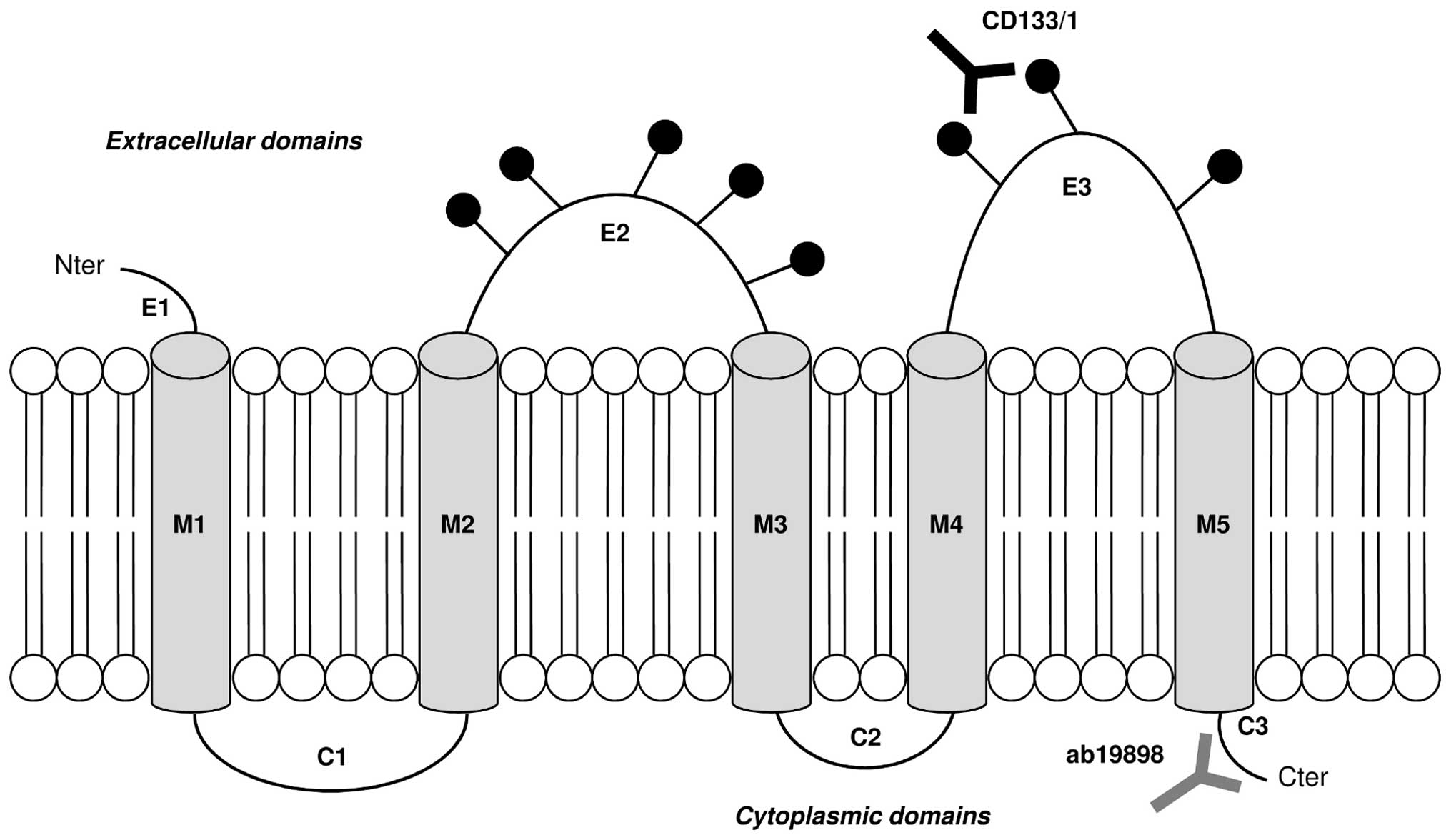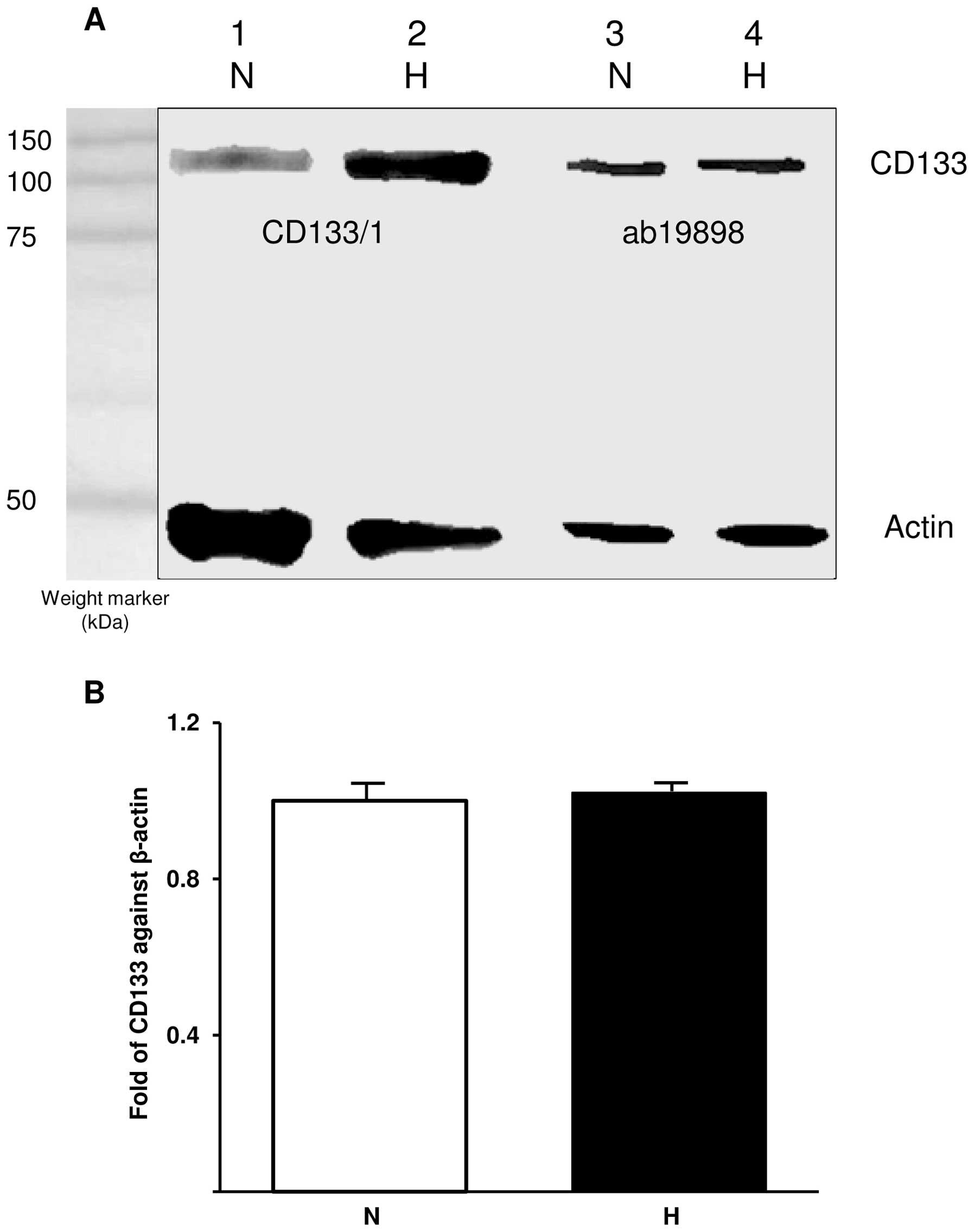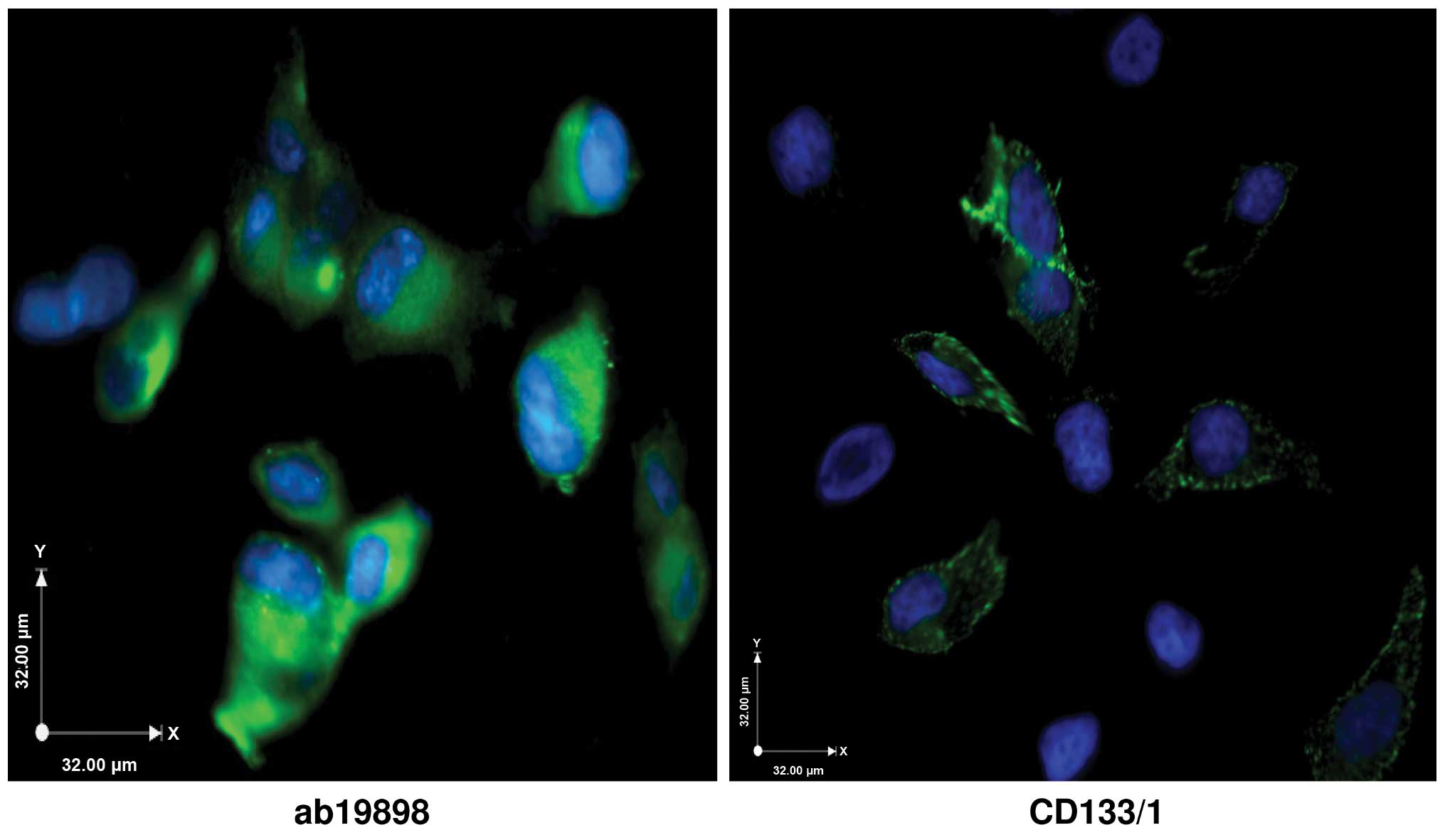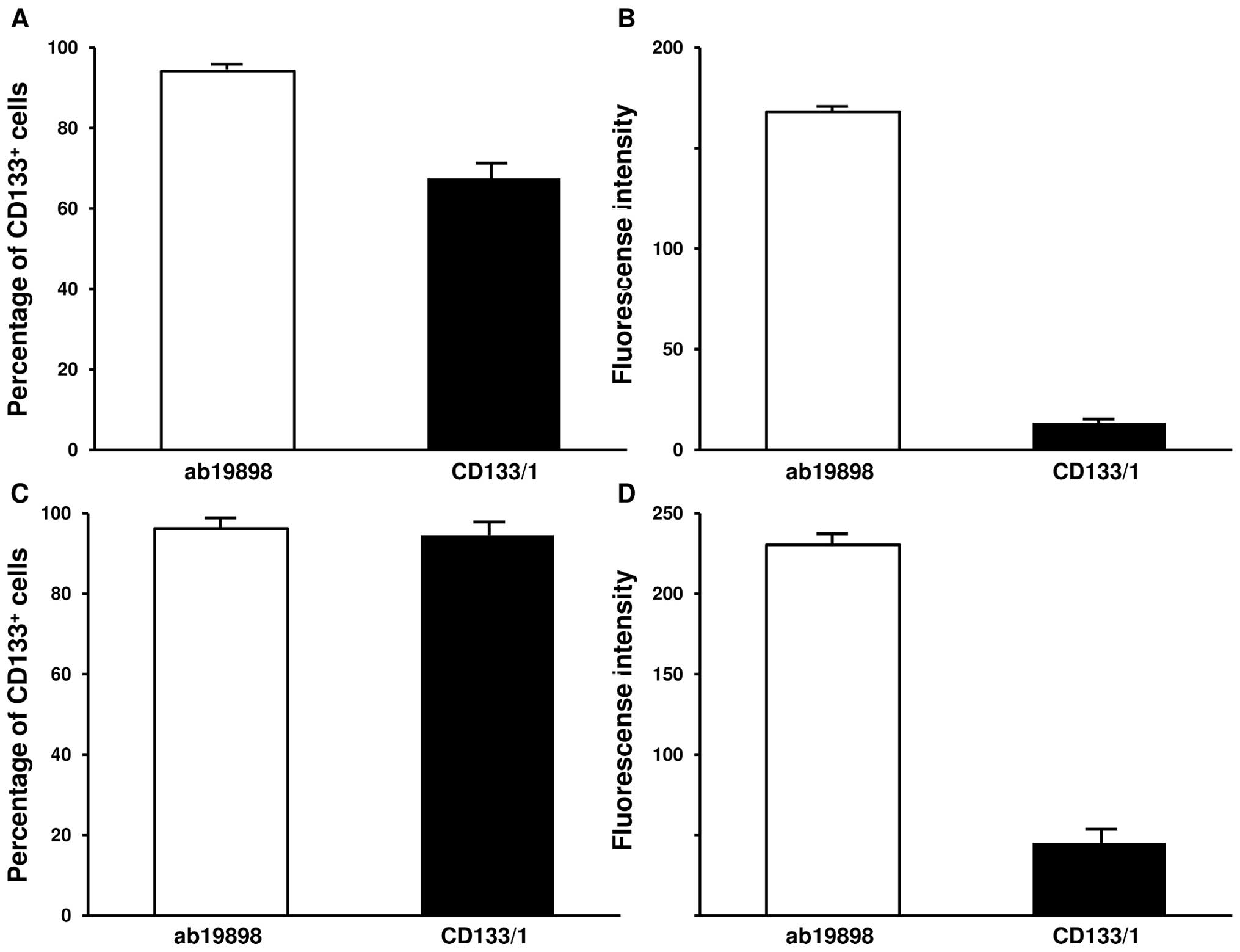|
1
|
Singh SK, Clarke ID, Terasaki M, Bonn VE,
Hawkins C, Squire J and Dirks PB: Identification of a cancer stem
cell in human brain tumours. Cancer Res. 63:5821–5828.
2003.PubMed/NCBI
|
|
2
|
Wang J, Sakariassen PØ, Tsinkalovsky O,
Immervoll H, Bøe SO, Svendsen A, Prestegarden L, Røsland G, Thorsen
F, Stuhr L, Molven A, Bjerkvig R and Enger PØ: CD133 negative
glioma cells form tumors in nude rats and give rise to CD133
positive cells. Int J Cancer. 122:761–768. 2008. View Article : Google Scholar : PubMed/NCBI
|
|
3
|
Clément V, Dutoit V, Marino D, Dietrich PY
and Radovanovic I: Limits of CD133 as a marker of glioma
self-renewing cells. Int J Cancer. 125:244–248. 2009.PubMed/NCBI
|
|
4
|
Mizrak D, Brittan M and Alison MR: CD133:
molecule of the moment. J Pathol. 214:3–9. 2008. View Article : Google Scholar : PubMed/NCBI
|
|
5
|
Cheng JX, Liu BL and Zhang X: How powerful
is CD133 as a cancer stem cell marker in brain tumors? Cancer Treat
Rev. 35:403–408. 2009. View Article : Google Scholar : PubMed/NCBI
|
|
6
|
Campos B and Herold-Mende CC: Insight into
the complex regulation of CD133 in glioma. Int J Cancer.
128:501–510. 2011. View Article : Google Scholar : PubMed/NCBI
|
|
7
|
Sun Y, Kong W, Falk A, Hu J, Zhou L,
Pollard S and Smith A: CD133 (prominin) negative human neural stem
cells are clonogenic and tripotent. PLoS One. 4:1–10.
2009.PubMed/NCBI
|
|
8
|
Fargeas CA, Huttner WB and Corbeil D:
Nomenclature of prominin-1 (CD133) splice variants - an update.
Tissue Antigens. 69:602–606. 2007. View Article : Google Scholar : PubMed/NCBI
|
|
9
|
Osmond TL, Broadley KW and McConnell MJ:
Glioblastoma cells negative for the anti-CD133 antibody AC133
express a truncated variant of the CD133 protein. Int J Mol Med.
25:883–888. 2010.PubMed/NCBI
|
|
10
|
Bidlingmaier S, Zhu X and Liu B: The
utility and limitations of glycosylated human CD133 epitopes in
defining cancer stem cells. J Mol Med. 86:1025–1032. 2008.
View Article : Google Scholar : PubMed/NCBI
|
|
11
|
Oliver L, Olivier C, Marhuenda FB, Campone
M and Vallette FM: Hypoxia and the malignant glioma
microenvironment: regulation and implications for therapy. Curr Mol
Pharmacol. 2:263–284. 2009. View Article : Google Scholar : PubMed/NCBI
|
|
12
|
Evans SM, Judy KD, Dunphy I, Jenkins WT,
Hwang WT, Nelson PT, Lustig RA, Jenkins K, Magarelli DP, Hahn SM,
Collins RA, Grady MS and Koch CJ: Hypoxia is important in the
biology and aggression of human glial brain tumors. Clin Cancer
Res. 10:8177–8184. 2004. View Article : Google Scholar
|
|
13
|
Amberger-Murphy V: Hypoxia helps glioma to
fight therapy. Curr Cancer Drug Targets. 9:381–390. 2009.
View Article : Google Scholar : PubMed/NCBI
|
|
14
|
Donovan LK, Potter NE, Warr T and
Pilkington GJ: A Prominin-1-rich paediatric glioblastoma:
biological behaviour is determined by oxygen tension modulated
CD133 expression but not accompanied by underlying molecular
profiles. Transl Oncol. 5:141–154. 2012. View Article : Google Scholar
|
|
15
|
McCord AM, Jamal M, Shankavaram UT, Lang
FF, Camphausen K and Tofilon PJ: Physiologic oxygen concentration
enhances the stem-like properties of CD133+ human
glioblastoma cells in vitro. Mol Cancer Res. 7:489–497. 2009.
View Article : Google Scholar : PubMed/NCBI
|
|
16
|
Griguer CE, Oliva CR, Gobin E, Marcorelles
P, Benos DJ, Lancaster JR Jr and Gillespie GY: CD133 is a marker of
bioenergetic stress in human glioma. PLoS One. 3:e36552008.
View Article : Google Scholar : PubMed/NCBI
|
|
17
|
Platet N, Liu SY, Atifi ME, Oliver L,
Vallette FM, Berger F and Wion D: Influence of oxygen tension on
CD133 phenotype in human glioma cell cultures. Cancer Lett.
258:286–290. 2007. View Article : Google Scholar : PubMed/NCBI
|
|
18
|
Iida H, Suzuki M, Goitsuka R and Ueno H:
Hypoxia induces CD133 expression in human lung cancer cells by
up-regulation of OCT3/4 and SOX2. Int J Oncol. 40:71–79.
2012.PubMed/NCBI
|
|
19
|
Hermansen SK, Christensen KG, Jensen SS
and Kristensen BW: Inconsistent immunohistochemical expression
patterns of four different CD133 antibody clones in glioblastoma. J
Histochem Cytochem. 59:391–407. 2011. View Article : Google Scholar
|
|
20
|
Günther HS, Schmidt NO, Phillips HS,
Kemming D, Kharbanda S, Soriano R, Modrusan Z, Meissner H, Westphal
M and Lamszus K: Glioblastoma-derived stem cell-enriched cultures
form distinct subgroups according to molecular and phenotypic
criteria. Oncogene. 27:2897–2909. 2008.PubMed/NCBI
|
|
21
|
An Q, Burke GA, Dainton M, Harrison CJ,
Kempski H, Konn Z, Myooren W, Stewart A, Taj M, Webb D, Strefford
JC and Martineau M: Haploinsufficiency of the MLL and TOB2 genes in
lymphoid malignancy. Leukemia. 24:649–652. 2010. View Article : Google Scholar : PubMed/NCBI
|
|
22
|
Fargeas CA, Fonseca A, Huttner WB and
Corbeil D: Prominin-1 (CD133): from progenitor cells to human
diseases. Future Lipidology. 1:213–255. 2006. View Article : Google Scholar
|
|
23
|
Kemper K, Sprick MR, De Bree M, Vermeulen
L, Hoek M, Zeilstra J, Pals ST, Mehmet H, Stassi G and Medema JP:
The AC133 epitope, but not the CD133 protein, is lost upon cancer
stem cell differentiation. Cancer Res. 70:719–729. 2010. View Article : Google Scholar : PubMed/NCBI
|
|
24
|
Gahmber CG and Tolvanen M: Why mammalian
cell surface proteins are glycoproteins. Trends Biochem Sci.
21:308–311. 1996. View Article : Google Scholar : PubMed/NCBI
|
|
25
|
Taïeb N, Maresca M, Guo X, Garmy N, Fatini
J and Yahi N: The first extracellular domain of the tumour stem
cell marker CD133 contains an antigenic ganglioside-binding motif.
Cancer Lett. 278:164–173. 2009.PubMed/NCBI
|
|
26
|
Birks SM, Danquah JO, King L, Vlasak R,
Gorecki DC and Pilkington GJ: Targeting the GD3 acetylation pathway
selectively induces apoptosis in glioblastoma. Neuro Oncol.
13:950–960. 2011. View Article : Google Scholar : PubMed/NCBI
|
|
27
|
Bar EE, Lin A, Bar EE, Lin A, Mahairaki V,
Matsui W and Eberhart CG: Hypoxia increases the expression of
stem-cell markers and promotes clonogenicity in glioblastoma
neuro-spheres. Am J Pathol. 177:1491–1502. 2010. View Article : Google Scholar : PubMed/NCBI
|
|
28
|
Ruan K, Song G and Ouyang G: Role of
hypoxia in the hallmarks of human cancer. J Cell Biochem.
107:1053–1062. 2009. View Article : Google Scholar : PubMed/NCBI
|
|
29
|
Lu X and Kang Y: Hypoxia and
hypoxia-inducible factors: master regulators of metastasis. Clin
Cancer Res. 16:5928–5935. 2010. View Article : Google Scholar : PubMed/NCBI
|
|
30
|
Fujiwara S, Nakagawa K, Harada H, Nagato
S, Furukawa K, Teraoka M, Seno T, Oka K, Iwata S and Ohnishi T:
Silencing hypoxia-inducible factor-1alpha inhibits cell migration
and invasion under hypoxic environment in malignant gliomas. Int J
Oncol. 30:793–802. 2007.
|
|
31
|
Hashimoto O, Shimizu K, Semba S, Chiba S,
Ku Y, Yokozaki H and Hori Y: Hypoxia induces tumor aggressiveness
and the expansion of CD133-positive cells in a hypoxia-inducible
factor-1α-dependent manner in pancreatic cancer cells.
Pathobiology. 78:181–192. 2011.PubMed/NCBI
|
|
32
|
Lee HC and Wei YH: Mitochondrial DNA
instability and metabolic shift in human cancers. Int J Mol Sci.
10:674–701. 2009. View Article : Google Scholar : PubMed/NCBI
|
|
33
|
Gogvadze V, Zhivotovsky B and Orrenius S:
The Warburg effect and mitochondrial stability in cancer cells. Mol
Aspects Med. 31:60–74. 2010. View Article : Google Scholar : PubMed/NCBI
|
|
34
|
Grandemange S, Herzig S and Martinou JC:
Mitochondrial dynamics and cancer. Semin Cancer Biol. 19:50–56.
2009. View Article : Google Scholar
|
|
35
|
Ishikawa K and Hayashi J: A novel function
of mtDNA: its involvement in metastasis. Ann NY Acad Sci.
1201:40–43. 2010. View Article : Google Scholar : PubMed/NCBI
|
|
36
|
Denko NC: Hypoxia, HIF1 and glucose
metabolism in the solid tumour. Nat Rev Cancer. 8:705–713. 2008.
View Article : Google Scholar : PubMed/NCBI
|
|
37
|
Semenza GL: Regulation of cancer cell
metabolism by hypoxiainducible factor 1. Semin Cancer Biol.
19:12–16. 2009. View Article : Google Scholar : PubMed/NCBI
|
|
38
|
Chiche J, Rouleau M, Gounon P,
Brahimi-Horn MC, Pouysségur J and Mazure NM: Hypoxic enlarged
mitochondria protect cancer cells from apoptotic stimuli. J Cell
Physiol. 222:648–657. 2010.PubMed/NCBI
|
|
39
|
Klimova T and Chandel NS: Mitochondrial
complex III regulates hypoxic activation of HIF. Cell Death Differ.
15:660–666. 2008. View Article : Google Scholar : PubMed/NCBI
|
|
40
|
De Haan C, Habibi-Nazhad B, Yan E, Salloum
N, Parliament M and Allalunis-Turner J: Mutation in mitochondrial
complex I ND6 subunit is associated with defective response to
hypoxia in human glioma cells. Mol Cancer. 3:192004.PubMed/NCBI
|
|
41
|
Soeda A, Park M, Lee D, Mintz A,
Androutsellis-Theotokis A, McKay RD, Engh J, Iwama T, Kunisada T,
Kassam AB, Pollack IF and Park DM: Hypoxia promotes expansion of
the CD133-positive glioma stem cells through activation of
HIF-1alpha. Oncogene. 28:3949–3959. 2009. View Article : Google Scholar : PubMed/NCBI
|
|
42
|
Lluis JM, Llacuna L, von Montfort C,
Bárcena C, Enrich C, Morales A and Fernandez-Checa JC: GD3 synthase
overexpression sensitizes hepatocarcinoma cells to hypoxia and
reduces tumor growth by suppressing the cSrc/NF-kappaB survival
pathway. PLoS One. 4:e80592009. View Article : Google Scholar
|
|
43
|
Kolenda J, Jensen SS, Aaberg-Jessen C,
Christensen K, Andersen C, Brünner N and Kristensen BW: Effects of
hypoxia on expression of a panel of stem cell and chemoresistance
markers in glio blastoma-derived spheroids. J Neurooncol.
103:43–58. 2011. View Article : Google Scholar : PubMed/NCBI
|
|
44
|
Cortes-Dericks L, Carboni GL, Schmid RA
and Karoubi G: Putative cancer stem cells in malignant pleural
mesothelioma show resistance to cisplatin and pemetrexed. Int J
Oncol. 37:437–444. 2010.PubMed/NCBI
|


















